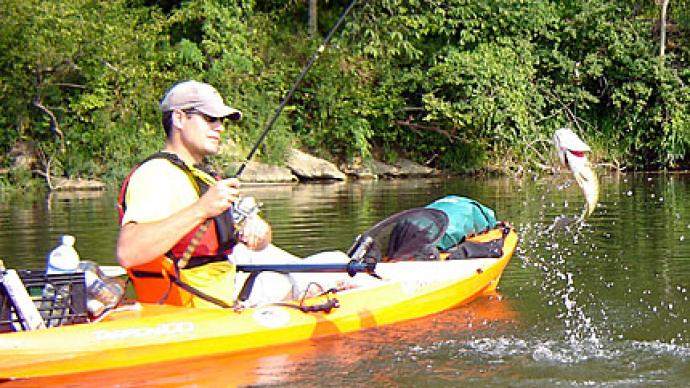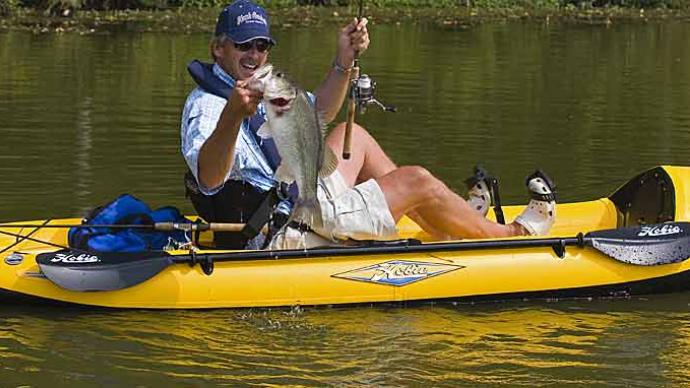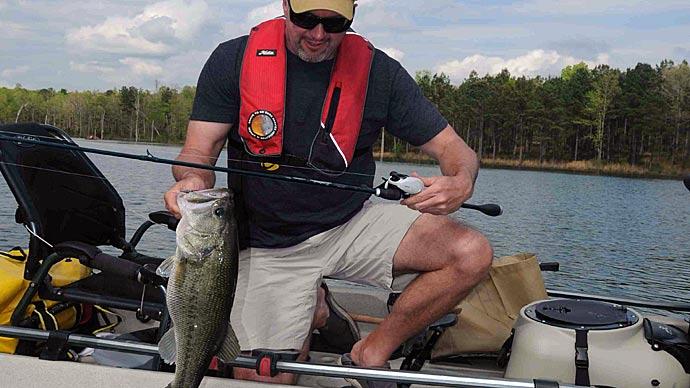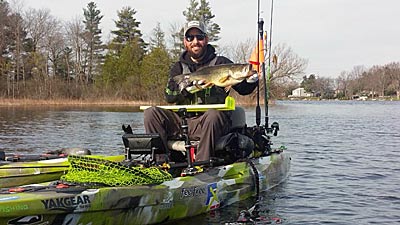
Mike McKinstry spent years fishing from his bass boat. When he first met the woman who became his wife, he would take her fishing on it, too. “I proposed to her on a bass boat,” he said. “So, [fishing] has been sort of our passion.”
But the bass boat wasn’t all hugs and kisses for the couple. They desperately wanted to fish one spot on their home lake but couldn’t access it with their boat. They needed kayaks to fish it. So, they purchased a couple, and it wasn’t long after that the bass boat was sold.
Access is one way that kayaks have changed McKinstry’s bass fishing. Three years ago, he left his full-time job to concentrate on his company, Bassquatch Clothing. And while he still competes in some kayak bass tournaments, his fishing has expanded, traveling across the country to salt- and freshwater kayaking destinations in search of adventure. He shares videos from each, along with how-to segments and tours of recent ICAST fishing industry trade shows, on his YouTube channel, Bassquatch Hunter TV.
McKinstry’s kayaks are Feelfree Lures. “I chose that kayak because I came from the bass boat world and wanted something stable,” he said. Like many modern fishing kayaks, these allow anglers to stand while fishing.
McKinstry rigs each of his kayaks — his fleet includes three at the moment — slightly different. His tandem, for example, doesn’t have a front seat. The extra space makes filming easier. But he adds accessories to each, some simple and others more involved. They all improve his time on the water and can do the same for any kayak angler. Here are five of them.
Rod holders

While McKinstry found familiarity in his kayak’s stability, one thing was missing. “There isn’t a deck like in a bass boat, so you can’t just lay a rod down,” he said. That can make unhooking a bass, retying a knot, or changing lures cumbersome. With only two hands, you can’t hold onto everything simultaneously.
So, a rod holder is one of the first additions McKinstry makes to any kayak. “It’s probably my most valuable piece of gear,” he said. The holder, attached to a YakGear Railblaza mount, is placed next to his seat for quick and easy access.
Anchor
McKinstry started kayak fishing because of the mobility it offered. But more often than not now, he wants to stay in one spot. “Every time I make a cast, my anchor is down,” he said. “I use it nonstop.”
Anchors make fishing from paddle-powered kayaks easier. Wind and current can quickly move it away from a spot with no means to hold it in place while casting. “I can be [moved up to] 20 yards depending on how long the retrieve is,” McKinstry said. Drop an anchor, and you can keep casting at the same spot.
McKinstry uses an Anchor Wizard, an aftermarket winch that allows him to quickly retrieve or deploy his anchor in up to about 30 feet of water, depending on which way he turns its handle. But he wasn’t completely sold on it at first. Most kayak anchors weigh about 4 pounds and are of the grapnel style. “A lot of people don’t think they need a winch for [a kayak] anchor,” he said. “But as soon as I got it, I realized how good it was.” Speed is its primary benefit, but keeping the anchor line neatly stored is not far behind. When pulled in by hand, it piles on the floor where it can tangle in itself and snag hooks.
The shallow-water anchor craze that has overtaken the bass boat market has made its way into kayak fishing. McKinstry used one, but he stopped when finding water shallow enough and bottom soft enough to use it became a chore. Those are rarely an issue with a traditional anchor.
Not all kayaks need an anchor. Suppose yours is equipped with pedals or a motor, then staying in one position while fishing won’t be an issue.
Electronics
Fishing electronics, powered by small 12-volt batteries such as those used with home security systems, are almost a standard feature on fishing kayaks. McKinstry uses a Humminbird Helix 7 and Lowrance Hook 2 on his Feelfree kayaks, which feature a removable “sonar pod” that incorporates the unit, transducer, and battery. “When I get home, I grab the pod and take it in the house,” he said. There he charges the battery.
Electronics help you pick apart a spot, catching as many bass as possible. That’s important because your range in a kayak is limited; you can only paddle or pedal so far. And you won’t need a fish finder with a giant screen on a kayak because you sit so close to it. That keeps everything — even with a split-screen — in focus.
In today’s connected world, reliving fishing adventures on social media is nearly as important as enjoying them the first time. Most kayak anglers mount cameras to capture the action. McKinstry is no exception, though creating a fishing show involves a few more than the average kayak angler. “I travel on the water with up to seven cameras,” he said. He mounts several of them on his kayak, uses a drone, and stashes a DSLR camera under his seat.
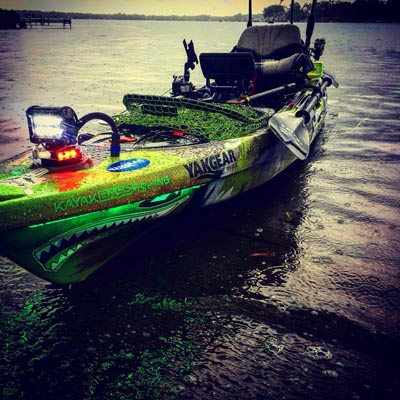
McKinstry said if he had to choose one spot on his kayak to mount a camera, it would be the stern. There, he mounted two YakGear Railblaza camera booms — one of which is almost a yard long — in an “L” shape. It creates many camera angles. He can grab it with one hand while holding a bass in the other, spinning it for a 180-degree pan of bass, angler, and scenery. It also provides side and water-level views.
Storage
Kayaks lack internal storage without decks, a narrow beam, and a relatively short length. While some have a sealable compartment or two, most kayak anglers pack their tackle and gear inside bags or crates, which ride directly behind their seat.
McKinstry uses Feelfree’s Crate Bag, which can be color-coordinated to some of its kayaks. Its large center compartment handles utility boxes of hard baits and bags of soft plastics. He said its external pockets organize several items, including sunscreen, pliers, terminal tackle, and more bags of soft plastics if needed. There’s even a removable waist pouch. Load it with essentials and strap it on if you’re interested in beaching your kayak and fishing on foot for a bit. And the bag has five-rod holders.
Any tackle storage needs to be secured to the kayak so it doesn’t end up on the bottom if you take a spill. Your rods are no different. Some anglers attach them to their kayak with specially designed leashes. But McKinstry said that can become a chore, and the leashes can interfere with fishing. It’s similar to the foam floats that attach to a rod’s blank directly in front of the handle. So, he offers a different option.
McKinstry attaches a Savur Outdoors retrieval system to the butt of each of his rods. If it falls overboard, the device releases a bobber. Grab it and pull on the attached line, bringing your outfit back from the depths. There are other versions for different types of gear. “I also use them on my GoPro [camera] mounts,” he said.
Safety gear
McKinstry said that kayak anglers must select — and wear — a well-fitting personal floatation device. PFDs come in two varieties. Many bass anglers prefer an inflatable one, whether they fish from a boat or kayak. When submerged or its cord pulled, it inflates, floating the wearer to the water’s surface. They are lightweight and trim, making them easy to wear all day, even in the hottest weather.
McKinstry wore an inflatable PFD until he flipped his kayak in a hail storm. Wearing winter clothes and boots, which acted like anchors once filled with water, he couldn’t swim or reach the string to inflate his PFD. Luckily, he was able to cling to his overturned kayak until reaching safety.
Now McKinstry wears the other type of PFD, which is filled with floatation. His NRS Chinook is comfortable, he said, and sports pouches where he keeps often-used items such as pliers. And best of all, he never has to worry about it inflating.
McKinstry adds more safety features to his kayaks. While they would help any kayaker, they’re essential to him because he spends many days fishing busy Lake St. Clair, the smallmouth-filled spot between lakes Erie and Huron near Detroit. “If I didn’t have my flagpole and light, I would have been run over by now,” he said. Both make him more visible to other boaters, especially during low-light conditions and foul weather.
The pole, which is attached to the stern of McKinstry’s kayak and rises above his head, sports a flag and a light, which shines 360 degrees. “The light comes off and on anytime you want,” he said. For example, it can be swapped for a rod holder if you’re standing and fishing during daylight hours. It will even accept a camera mount.
McKinstry also adds LED lights along the sides of his kayak. When turned on, they make it glow. And he mounts a spotlight on the bow, which helps him navigate and alerts other boats to his location. “The farther I can be seen, the safer I am,” he said.


